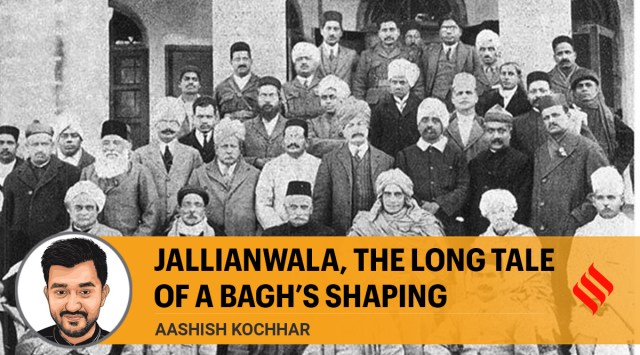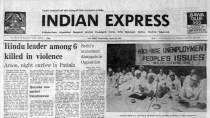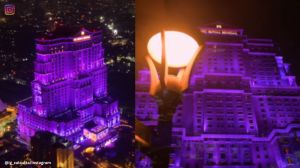- India
- International
Jallianwala, the long tale of a Bagh’s shaping
Aashish Kochhar writes: The recent noise has also shed light on the fact that the 1919 massacre wasn’t a climax but the beginning of a series of struggles and changes for the monument, which it continues to face more than a century later.
 Senior Congress leaders at Amritsar Town Hall after the party’s annual session in 1919. It was held in Amritsar that year as a tribute to those killed. (Gandhi Heritage Portal)
Senior Congress leaders at Amritsar Town Hall after the party’s annual session in 1919. It was held in Amritsar that year as a tribute to those killed. (Gandhi Heritage Portal)Written by Aashish Kochhar
Recently, Prime Minister Narendra Modi virtually inaugurated the renovated Jallianwala Bagh complex, inviting accusations of “diluting the essence” of the national monument. So far, the Bagh complex was silent, remembered only during conversations about the tragic massacre of April 13, 1919. The recent noise has also shed light on the fact that the 1919 massacre wasn’t a climax but the beginning of a series of struggles and changes for the monument, which it continues to face more than a century later.
Originally, Jallianwala Bagh was part of the katra or neighbourhood of Himmat Singh ‘Jallewal’, a courtier in the service of Raja Jaswant Singh of Nabha. It was called ‘Jallewal Bagh’ after his name, till the locals started mispronouncing it as ‘Jallianwala Bagh’. Later, for years it was just an ignored open space. In fact, it wasn’t even a bagh or garden, but an irregular quadrangle of uneven ground, walled in some parts. In other parts, the backs of houses that had encroached right up to it made its boundary. A part of it was used as a dumping ground!
At the time of the massacre in 1919, the Bagh had a narrow entrance. Inside, there was the samadhi of the mother of Sardar Sant Prakash Singh, the first Sikh Inspector-General of Police of Punjab. Near the memorial were a few date palms. Also, there was a dry well and a few huts inhabited by dhobis. The narrow entrance, the samadhi and the well exist to this day, but have seen changes under the renovation.
Apart from two demonstrations held at the complex against the Rowlatt Act by the Indian National Congress and local businessmen on March 30 and April 6, 1919, no major event had ever taken place at the complex before. Till the April 13 massacre.

As a tribute to those killed, the Indian National Congress and Muslim League organised their annual sessions in Amritsar in December later that year, which were presided over by Motilal Nehru and Hakim Ajmal Khan respectively. The events were attended by Bal Gangadhar Tilak, Annie Besant, Bipin Chandra Pal, Chittaranjan Das, Madan Mohan Malaviya, V S Srinivasa Sastri, Muhammad Ali Jinnah, Ali brothers and Mahatma Gandhi.
It was never confirmed, but it is believed that the British government wanted to turn the Bagh into a cloth market to obliterate any reminder of the massacre. To foil their plans, the Congress passed a resolution to construct a memorial at the site. Mahatma Gandhi issued an appeal for donations and a trust was set up with Madan Mohan Malaviya as president and Sashti Charan Mukherjee as secretary, whose family continues to be the Bagh’s caretaker.
Through the donations, they purchased the Bagh from its 34 original owners. Even though the British government refused to allow the construction of a memorial, the Bagh was revered as sacred to the freedom struggle and national leaders would visit it regularly and some would even take back the ‘sacred clay’ of the complex.
It was only after 1947 that the Government of India passed the Jallianwala Bagh National Memorial Act 1951, making it the first national monument of the country governed by an Act of Parliament that had the prime minister as its chairperson. Since the Jallianwala Bagh Memorial Committee was set up by the Congress before Independence, the Nehru government assigned permanent membership of the trust to the president of the Congress.
It was during this time, in the 1950s, that the first major renovation took place at the complex. First, the Bagh had to be filled in to raise the ground by over 5 feet, to bring it up to level with the road outside. Then, in 1957, construction of the central pylon started. Its design was prepared by T R Mahendra and an American named Benjamin Polk — leading architects working in Delhi at the time.
In 1961, the Amar Jyoti was inaugurated by the then president Dr Rajendra Prasad. On the four sides of the square platform of the memorial, the words, “In memory of martyrs —13 April 1919” were inscribed in Hindi, Punjabi, Urdu and English. That too has been shifted from its original position.
 In the 2000s, a photo gallery and light and sound show were set up inside the complex. The show was nixed soon, and the gallery, along with two others, has been updated with modern elements in the recent renovation. A half-hour light and sound show is also held now using the Bagh’s pylon as projection screen.
In the 2000s, a photo gallery and light and sound show were set up inside the complex. The show was nixed soon, and the gallery, along with two others, has been updated with modern elements in the recent renovation. A half-hour light and sound show is also held now using the Bagh’s pylon as projection screen.
In 2016, a flame-shaped white stone statue with the faces of the victims carved as motifs was erected outside the Bagh, as part of the Heritage Street Project. The statue also has names of those killed in the massacre inscribed on platform beneath it.
Two years later, a 10-feet marble statue of Udham Singh was unveiled at the entrance. Singh had killed Michael O’Dwyer to avenge the massacre of 1919 and was hanged for it. O’Dwyer was the governor of Punjab at the time of the killings.
In 2019, the NDA government passed the Jallianwala Bagh National Memorial (Amendment) Bill. It includes a provision to remove the president of the Congress as a permanent trustee of the Memorial.
The writer is a student of history at Jamia Milia Islamia based in Amritsar
40 Years Ago
EXPRESS OPINION
Best of Express
More Explained
Apr 18: Latest News
- 01
- 02
- 03
- 04
- 05









































